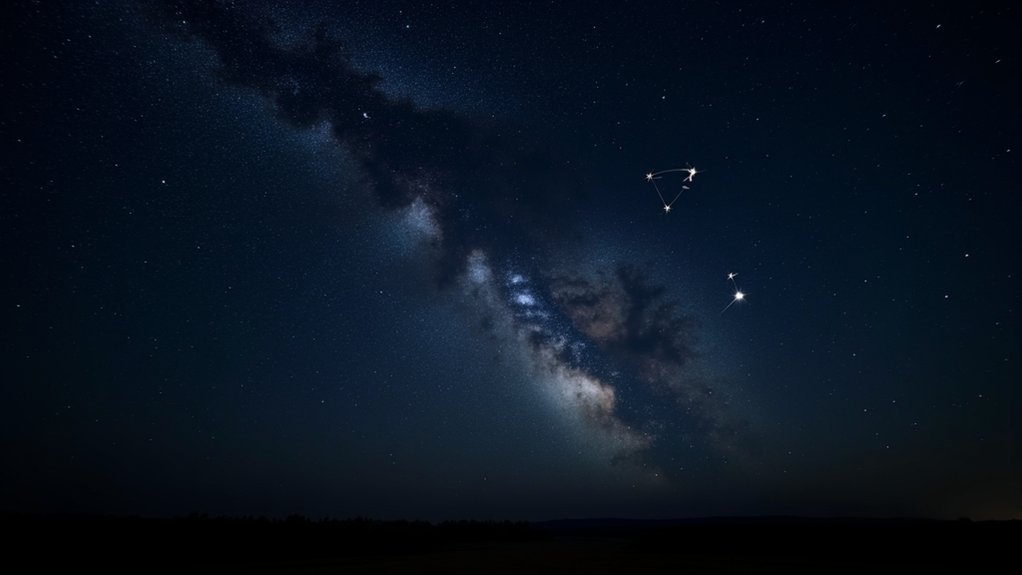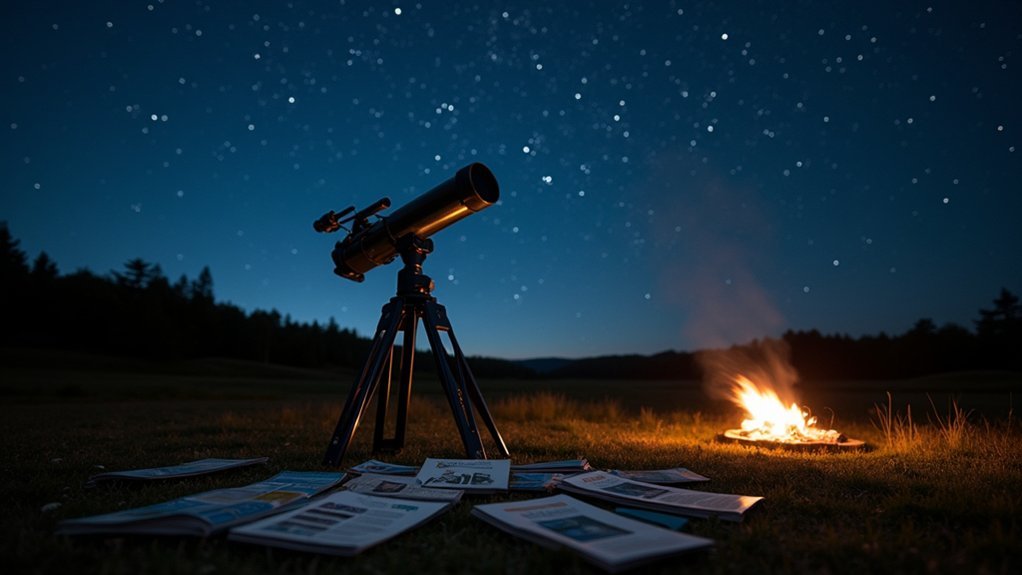To spot the North Star (Polaris) tonight, first locate the Big Dipper constellation in the northern sky. Identify the two stars at the end of the Dipper’s “bowl” called Merak and Dubhe. Draw an imaginary line from Merak through Dubhe and extend it about five times the distance between them. You’ll find Polaris along this line—it’s moderately bright and remains fixed while other stars rotate around it. The sections below will help you navigate seasonal variations and avoid common mistakes.
Numeric List of 12 Second-Level Headings

When exploring the night sky to find the North Star, you’ll need to follow a methodical approach.
Let’s break down the process into twelve clear steps:
- Identify the Big Dipper in Ursa Major
- Locate Merak and Dubhe (the pointer stars)
- Measure five times the distance between pointers
- Confirm you’ve found Polaris
- Recognize the Little Dipper constellation
- Understand Polaris’s fixed position
- Use Polaris to find true north
- Adjust for your location in the Northern Hemisphere
- Account for seasonal variations
- Distinguish Polaris from surrounding stars
- Practice daytime preparation
- Apply navigation techniques with the North Star
These steps will guarantee you can confidently find the North Star regardless of when you’re stargazing, giving you a reliable celestial landmark for navigation or astronomy pursuits.
The Basics of Polaris and Its Significance
Sailors, explorers, and stargazers throughout history have relied on a single, steadfast light in the night sky. This beacon is Polaris, commonly known as the North Star, which holds a unique position near the north celestial pole.
Unlike other stars that appear to move across the heavens, Polaris remains virtually fixed, making it invaluable for navigation.
When you spot this moderately bright 2nd-magnitude star (approximately the 50th brightest in our night sky), you’re looking at what ancient Egyptians and Vikings used to guide their journeys.
What makes Polaris particularly useful is that its height above the horizon directly corresponds to your latitude. By measuring this angle, you can determine your position on Earth’s northern hemisphere—a technique that’s served travelers for centuries.
Understanding the Night Sky’s Rotation Pattern

When you observe the night sky, you’ll notice stars appear to rotate around Polaris because Earth spins on its axis, which points almost directly at this stationary beacon.
This rotation creates predictable patterns as stars circle the celestial pole, with those closest to Polaris (called circumpolar stars) never setting below the horizon.
You can visualize this motion by taking long-exposure photographs of the northern sky, which capture stunning circular star trails centered around the North Star.
Earth’s Axis Role
Although stars fill our night sky, only one appears to remain nearly fixed as all others wheel around it in stately circles. This phenomenon occurs because Earth’s axis—tilted at 23.5 degrees—points almost directly at Polaris, the North Star.
| Earth’s Axis Facts | Impact on Navigation |
|---|---|
| Tilted at 23.5° | Creates seasonal changes |
| Points to celestial north pole | Makes Polaris visible |
| Maintains same orientation as Earth orbits | Provides consistent reference point |
| Experiences precession over 26,000 years | Polaris won’t always be North Star |
| Rotation causes stars to “move” east to west | Polaris remains stationary |
When you locate Polaris, you’re finding true north. The star’s height above your northern horizon directly corresponds to your latitude—a 40° latitude places Polaris 40° above the horizon, making it an invaluable tool for navigation.
Circumpolar Star Motion
The Earth’s constant rotation creates a fascinating celestial spectacle each night. As our planet spins, stars appear to travel in circular paths across the sky.
However, if you’re located above 41 degrees north latitude, you’ll notice something remarkable: circumpolar stars never disappear below the horizon. These persistent companions of the northern part of the sky revolve around Polaris, which remains virtually motionless.
The Big Dipper, part of Ursa Major, is the most recognizable circumpolar asterism and serves as your reliable pointer to locate the North Star. While other stars rise in the east and set in the west, these celestial landmarks maintain a consistent position relative to your location.
The higher your latitude, the more elevated these circumpolar stars will appear, making them invaluable for navigation throughout human history.
Finding the Big Dipper in Different Seasons
The Big Dipper rotates around Polaris throughout the year, changing its position while remaining visible in the Northern Hemisphere regardless of season.
During spring, you’ll find the Dipper high in the northeastern sky after sunset, whereas in fall, it sits lower on the northern horizon, making it somewhat harder to spot.
These seasonal differences don’t affect the Dipper’s reliability as your celestial signpost—its pointer stars will always direct you to Polaris, no matter where it appears in its yearly cycle.
Seasonal Dipper Rotations
Circling endlessly around Polaris throughout the year, the Big Dipper changes its position in the night sky as Earth orbits the sun. This celestial rotation makes the northern constellation appear in different orientations depending on when you’re stargazing.
In spring, you’ll find the Big Dipper high in the northeastern sky after sunset, perfectly positioned to help locate Polaris.
Summer brings the constellation almost directly overhead, creating an ideal viewing opportunity.
As autumn approaches, the Dipper sinks lower toward the northern horizon in evening hours, requiring a bit more effort to spot.
Winter shifts its position westward earlier in the night.
Despite these seasonal movements, the Big Dipper remains visible year-round for Northern Hemisphere observers, continuously pointing the way to the North Star like a celestial compass.
Spring Vs Fall Visibility
While tracking the Big Dipper throughout the year reveals fascinating patterns, spring and fall present particularly contrasting viewing experiences.
During spring evenings, especially in March, you’ll find the Big Dipper riding high in the northeastern sky at nightfall, offering ideal visibility for locating Polaris.
In contrast, fall provides limited opportunities to spot the Big Dipper, as its position shifts closer to the horizon.
However, if you’re located north of the 41st parallel, you’re in luck—the Big Dipper is circumpolar in these regions, meaning it never dips below the horizon.
For viewers north of the 35th parallel, you can actually find the Big Dipper at any hour of the night regardless of season, though its changing position affects how you’ll use it to locate Polaris.
Using the Pointer Stars as Your Guide

Finding the North Star becomes remarkably simple once you understand how to use the pointer stars as navigational aids.
First, locate the Big Dipper, a prominent constellation resembling a large spoon with seven bright stars. The two stars forming the outer edge of the dipper’s bowl are Merak and Dubhe – these are your pointer stars.
Draw an imaginary line starting at Merak, through Dubhe, and extend it about five times the distance between them. This reliable path leads directly to Polaris, a moderately bright star that marks the end of the Little Dipper’s handle.
Unlike other stars that appear to move throughout the night, Polaris remains fixed near the north celestial pole.
This method works year-round in the Northern Hemisphere, making it an invaluable skill for beginners and experienced stargazers alike.
Measuring the Distance to Polaris
You’ll find that astronomers use angular measurement techniques to determine Polaris’s impressive 433 light-year distance from Earth.
When you observe the North Star from different points in Earth’s orbit, you can detect its subtle positional shift through parallax calculations.
This precise method allows scientists to triangulate cosmic distances, connecting our earthbound observations to the vast scale of our galaxy.
Angular Measurement Techniques
Once you’ve located Polaris in the night sky, measuring its angular distance from the horizon provides valuable navigational information. Your latitude directly corresponds to Polaris’s angle above the horizon—a fundamental principle that explorers have used for centuries.
For accurate angular measurement, find a spot with an unobstructed line of sight to the northern sky.
- Feel the ancient connection to mariners and explorers who relied on these same stars to navigate vast, unknown oceans
- Experience the thrill of pinpointing your exact position on Earth using nothing but your eyes and simple tools
- Marvel at how this celestial constant has guided countless travelers home through darkness
You can use a protractor, smartphone app, or even your extended fist (which spans roughly 10 degrees) to measure Polaris’s angle, confirming your precise latitude on our planet.
Parallax Calculation Methods
While angular measurements tell you your position on Earth, the stars themselves exist at vastly different distances from us. Polaris, our North Star, lies approximately 433 light-years away—a distance determined through parallax calculations.
You can understand parallax by picturing Earth’s orbit around the Sun. Astronomers observe Polaris from opposite sides of this orbit, six months apart, and measure its tiny apparent shift against background stars.
The resulting parallax angle for Polaris is incredibly small—just 0.0083 arcseconds—requiring extremely precise measurements.
This method provides the foundation for cosmic distance calculations. When you gaze at Polaris tonight, you’re looking at light that began its journey over four centuries ago, demonstrating the vast scale of our universe and the power of modern astronomical techniques.
Verifying You’ve Found the Right Star

How can you be certain you’ve spotted Polaris among countless stars in the night sky? First, confirm you’re looking at the last star in Ursa Minor’s handle—the Little Dipper.
Finding Polaris requires certainty—look for the final star adorning Ursa Minor’s handle within the Little Dipper constellation.
The Big Dipper serves as your celestial pointer; draw an imaginary line from the two outer stars of its bowl toward the upper right to find Polaris.
When verifying you’ve found the genuine North Star, check these telltale signs:
- It remains fixed in the northern sky while all other stars appear to rotate around it
- It shines as a moderately bright 2nd-magnitude star—not the brightest, but distinctly visible
- It stands as the brightest of the seven stars forming the Little Dipper constellation
Cross-reference these characteristics to confidently identify Polaris in your stargazing adventures.
The Little Dipper’s Relationship to Polaris
Since ancient times, the Little Dipper has served as Polaris‘s celestial home. This small constellation, officially known as Ursa Minor, contains just seven stars, with Polaris shining most prominently at the end of its handle.
Unlike other stars that rise and set throughout the night, Polaris remains virtually stationary in the sky, making it an invaluable navigation tool.
You’ll find the Little Dipper easier to spot once you’ve located the more visible Big Dipper. Draw an imaginary line using the two stars at the outer edge of the Big Dipper’s bowl—they’ll point directly to Polaris.
In urban areas with light pollution, you might only see Polaris within the Little Dipper, while the constellation’s fainter stars remain hidden. For the best view, seek darker skies away from city lights.
Naked-Eye Navigation Techniques

Finding Polaris without tools remains one of humanity’s oldest navigation skills. The process begins with locating the Big Dipper in Ursa Major, a constellation visible year-round for observers above 35° latitude.
Identify the seven-star formation, then use the two stars forming the outer edge of the Big Dipper’s bowl—Merak and Dubhe—as pointer stars. Extend an imaginary line about five times the distance between these stars to find Polaris.
- Experience the same celestial connection that guided explorers across oceans and deserts for millennia
- Feel confident knowing you’ll never truly be lost as long as you can see the night sky
- Discover a profound sense of place within the universe each time you orient yourself using these ancient methods
Polaris remains fixed in the northern sky, making it your reliable navigation companion whenever you need direction.
Common Mistakes When Searching for Polaris
Why do so many stargazers struggle to locate Polaris? Despite its importance, Polaris is only the 50th brightest star, making it easy to confuse with other stars like Kochab in Ursa Minor.
You’ll often find yourself misled if you don’t first locate the Big Dipper as your reference point. A common mistake is failing to properly trace the line from the Big Dipper’s outer stars, Merak and Dubhe, to find Polaris at the Little Dipper’s handle end.
Unlike other stars, Polaris doesn’t rise or set but remains fixed in the northern sky, which can disorient observers expecting movement. Light pollution greatly complicates identification, so seek darker skies whenever possible.
How Latitude Affects Your View of Polaris
Your location on Earth significantly changes how you’ll view Polaris in the night sky. The North Star’s altitude above the northern horizon directly corresponds to your latitude—if you’re at 40 degrees north, Polaris sits approximately 40 degrees above the horizon.
As you travel northward, Polaris climbs higher in your sky. At latitudes above 41 degrees north, you’ll enjoy year-round visibility of Polaris thanks to the circumpolar Big Dipper.
However, crossing the equator means losing sight of this celestial landmark entirely.
- Experience the thrill of seeing Polaris nearly overhead when visiting far northern regions
- Feel the connection to ancient navigators as you gauge your latitude by Polaris’s position
- Witness the dramatic shift in Polaris’s angle when traveling just a few hundred miles north or south
Practicing Star-Finding in Light-Polluted Areas
Urban skyglow doesn’t have to prevent you from locating Polaris, despite the challenges it presents. In light-polluted areas, your best strategy is to use the Big Dipper as your celestial guide.
Look for this recognizable constellation high in the sky, especially during spring months like March when it’s most prominent.
Once you’ve found the Big Dipper, identify its two outer stars and draw an imaginary line extending about five times their distance. This line points directly to Polaris, the first bright star you’ll encounter.
For better results, find a spot with minimal obstruction and less artificial light if possible.
Can’t confirm your sighting? Smartphone star maps can help verify Polaris’s position by showing surrounding constellations, even when dimmer stars remain invisible to the naked eye.
Frequently Asked Questions
How Do I Find the North Star Tonight?
To find the North Star tonight, locate the Big Dipper, identify Merak and Dubhe at the bowl’s edge, and follow this line five times its length. You’ll reach Polaris, which stays fixed in the northern sky.
How Do I Locate the North Star in the Sky?
To locate the North Star, find the Big Dipper’s bowl, connect its two outer stars, and extend this line upward about five times their distance. You’ll see Polaris, a moderately bright star that remains fixed.
How Do You Find the Position of the North Star?
To find the North Star’s position, locate the Big Dipper first. Then, draw an imaginary line through the two stars at the bowl’s edge and extend it about five times their distance. You’ll reach Polaris.
Which Direction Are You Facing When You Face the North Star?
When you’re facing the North Star (Polaris), you’re facing true north. It’s that simple! This makes Polaris an invaluable navigational tool, as it’ll always indicate the northern direction in the Northern Hemisphere.
In Summary
You’ve now learned how to find the North Star no matter your location or the season. With practice, you’ll spot Polaris instantly, enhancing your stargazing experience and navigation skills. Remember to use the Big Dipper‘s pointer stars, account for your latitude, and don’t be discouraged by light pollution. The North Star has guided travelers for centuries—now it’s your celestial companion too.





Leave a Reply